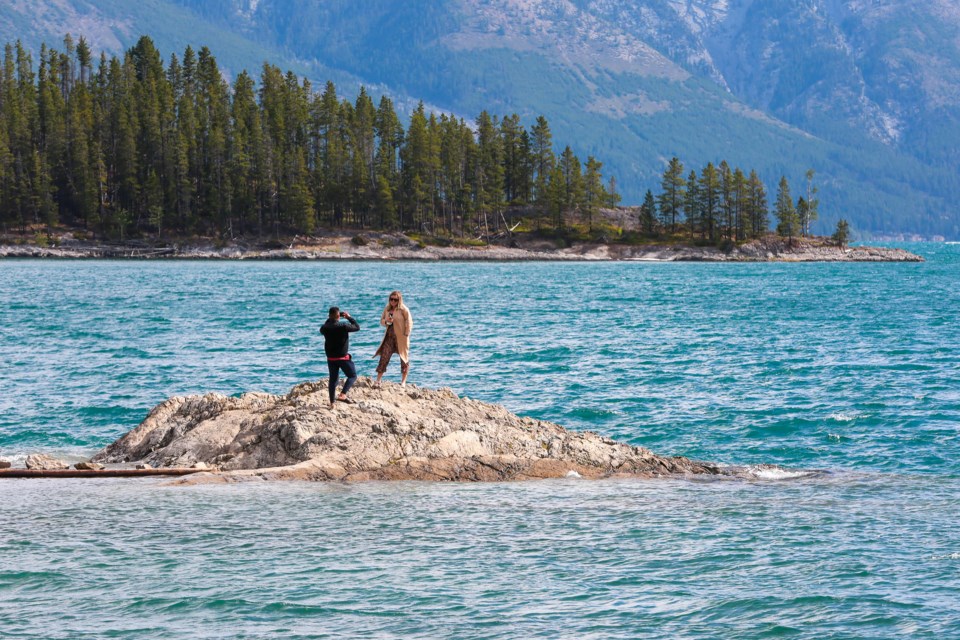BANFF – All motorized boats must now undergo a Parks Canada inspection before being launched at Lake Minnewanka in a bid to prevent the risk of introducing aquatic invasive species.
In addition, all recreationalists wanting to take non-motorized watercraft such as kayaks, canoes or stand-up paddleboards onto park lakes and rivers must also go through an inspection or fill out the mandatory self-certification program to meet so-called clean, drain, dry requirements.
“We’re trying to prevent the introduction of aquatic invasive species,” said Daniella Rubeling, Parks Canada’s visitor experience manager for Banff National Park.
“We’re building on the program we had last year and we’re tightening things up a little bit. We’re doing our due diligence in terms of preventing the introduction of AIS (aquatic invasive species).”
Lake Minnewanka is the only water body in Banff National Park where motorized boats are allowed and the inspection station on the Lake Minnewanka Loop Road is open for the season.
Rubeling said what is new this year is that all motorized watercraft will require a Parks Canada inspection.
“The provincial AIS inspections won’t be accepted,” she said. “They do need to go through our inspection station in order to launch in Minnewanka.”
Like last year, all non-motorized watercraft, fishing equipment and water-related gear must comply with the clean, drain, and dry requirements at least a minimum 48 hours before use in any park lake or river.
The mandatory permit applies to any canoe, kayak, raft, stand-up paddleboard or inflatable boat or toy, as well as fishing equipment like rods, tackle, waders, wading boots and gloves. Lifejackets, throw bags, water shoes, wetsuits and water toys are also included.
The mandatory self-certification permit can be filled out online at www.pc.gc.ca/en/pn-np/ab/banff/activ/nautiques-sports/nettoyez-videz-sechez-clean-drain-dry/permis-permit, or at one of about 30 self-certification stations located throughout the park.
However, outdoor enthusiasts can also choose to use the in-person inspection station at Lake Minnewanka and another one located at the former park-and-ride lot off the Trans-Canada Highway east of the hamlet of Lake Louise.
Rubeling said if people can’t meet the 48-hour clean, drain, dry requirement – which is based on a best practice for whirling disease management – they can also visit either station.
“The staff there will inspect canoes, kayaks, paddleboards and ask a bunch of questions about where they’ve been,” she said.
“If they’re found to be cleaned, drained and dried, and haven’t been in high-risk AIS positive waters, staff there may issue an inspection permit for that day so they could go ahead and launch.”
Aquatic invasive species can be introduced through activities such as canoeing, kayaking, stand-up paddleboarding and fishing.
They can alter aquatic ecosystems, cause irreversible damage and impact already vulnerable species-at-risk, such as westslope cutthroat trout.
“We’ve seen the impacts locally with whirling disease, with Johnson Lake having to be drained and closed for several years in order to try and eliminate that form that water body,” said Rubeling.
Quagga and zebra mussels were believed introduced by trans-continental shipping from the Baltic Sea to the Great Lakes region of Canada and in the United States in the 1980s.
These mussels have spread in Ontario and Quebec and have been discovered in Lake Winnipeg, Manitoba. They are also found in many American states as far west as California. However, they have not yet spread to British Columbia or Alberta, although they have been intercepted on boats at provincial inspection stations.
“Species like zebra mussels and quagga mussels can ruin boat motors, plug water intake, and can drastically alter the ecological community in our water bodies,” said Rubeling.
“This could result in impacts to angling as well as also infrastructure, ecological integrity and visitor experience.”
Rubeling said data collected from the mandatory permits helps Parks Canada understand how and where people are using the park’s lakes and rivers.
“We’ll be using that information to look at how we continue to adjust and adapt the program in years to come,” she said.
The Lake Minnewanka Loop Road inspection station for motorized and non-motorized inspections is open from 8 a.m. to 4 p.m. until June 4 before moving to peak season hours of 7 a.m. to 7 p.m. on June 5.
The Lake Louise inspection station, which is open for inspection on non-motorized watercraft only, is currently open from 8 a.m. to 4 p.m., but will have expanded hours of 8 a.m. to 8 p.m. starting June 5.
Anyone caught without the mandatory permit may be charged and face a maximum penalty of $25,000 in court. The mandatory permit program also applies to Kootenay and Yoho national parks.




